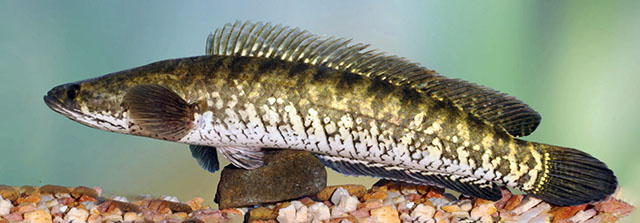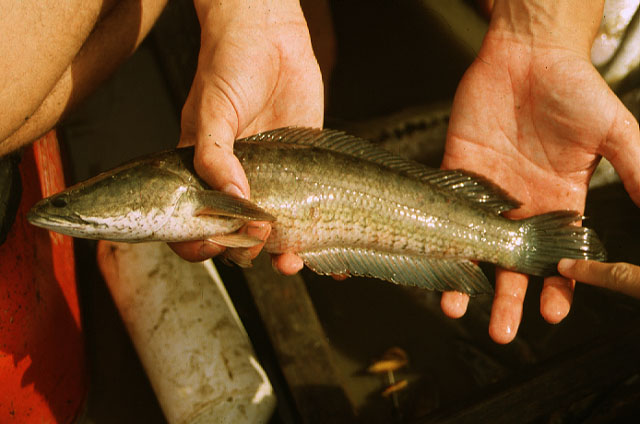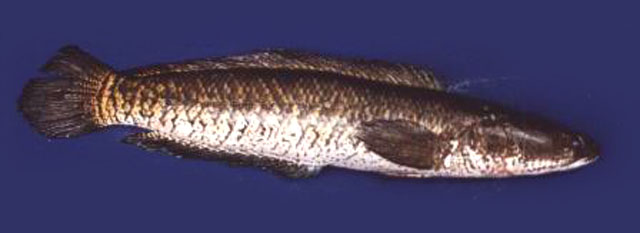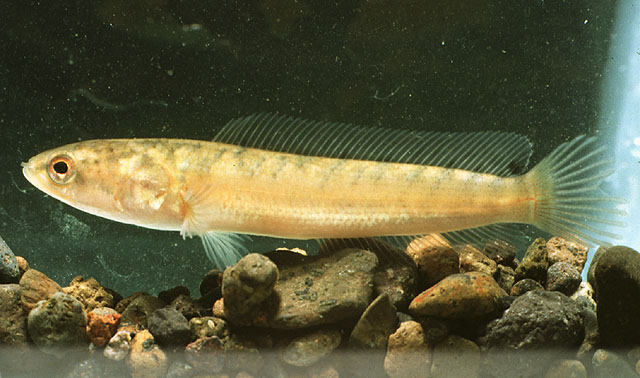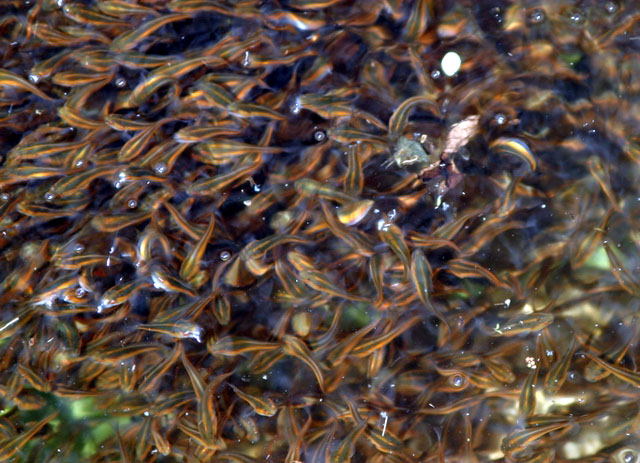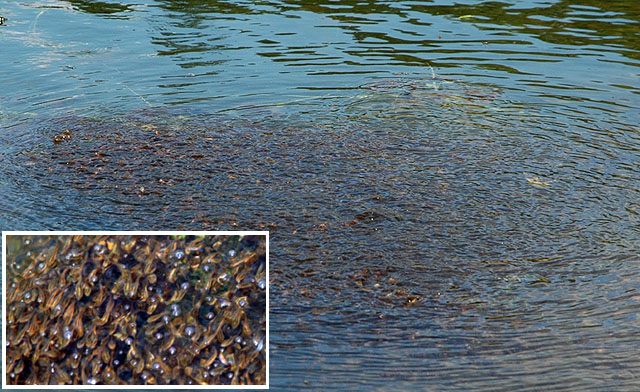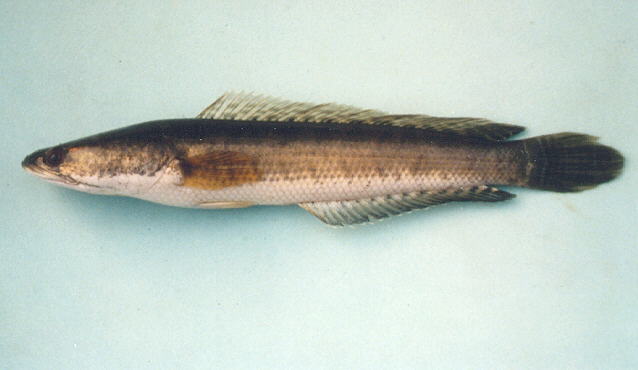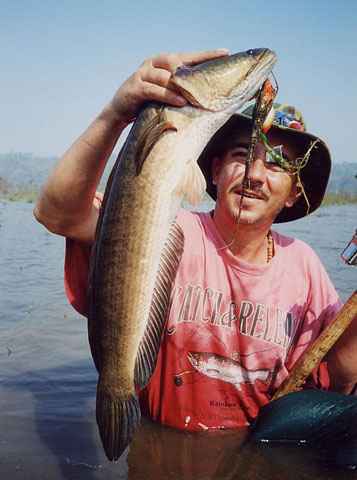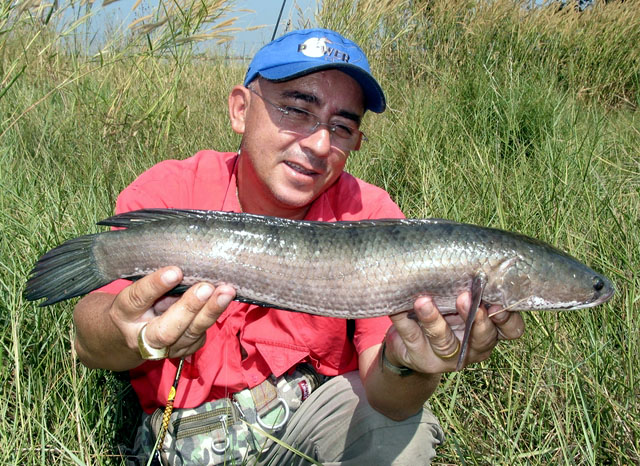Channa
striata
(Bloch,
1793)
Striped snakehead
View all media / Upload your photos and videos
Expand all
Classification / Names
Teleostei (teleosts) > Anabantiformes (Gouramies, snakeheads) >
Channidae (Snakeheads)
Etymology: Channa: Greek, channe, -es = an anchovy (Ref. 45335).
More on author:
Bloch.
Environment / milieu / depth range / climate zone / distribution range
Distribution
Asia: Pakistan to Thailand and south China. Several countries report adverse ecological impact after introduction.
Length at first maturity / Size / Weight / Age
Short description
Dorsal spines (total): 0; Dorsal soft rays (total): 38 - 43; Anal spines: 0; Anal soft rays: 23 - 27. Body sub-cylindrical; head depressed; caudal fin rounded (Ref. 2847). The dorsal surface and sides is dark and mottled with a combination of black and ochre, and white on the belly; a large head reminiscent of a snake's head; deeply-gaping, fully toothed mouth; very large scales (Ref. 44091).
Biology
Adults inhabit ponds, streams and rivers, preferring stagnant and muddy water of plains (Ref. 41236). Found mainly in swamps, but also occurs in the lowland rivers. More common in relatively deep (1-2 m), still water. Very common in freshwater plains (Ref. 4515, 57235). Occur in medium to large rivers, brooks, flooded fields and stagnant waters including sluggish flowing canals (Ref. 12975). Recorded as having been or being farmed in rice fields (Ref. 119549). Survive dry season by burrowing in bottom mud of lakes, canals and swamps as long as skin and air-breathing apparatus remain moist (Ref. 2686) and subsists on the stored fat (Ref. 1479). Feed on fish, frogs, snakes, insects, earthworms, tadpoles (Ref. 1479) and crustaceans (Ref. 2847). Undertake lateral migration from the Mekong mainstream, or other permanent water bodies, to flooded areas during the flood season and return to the permanent water bodies at the onset of the dry season (Ref. 37770). During winter and dry season, its flesh around coelomic cavity is heavily infested by a larval trematode Isoparorchis hypselobargi. Other parasites infecting this fish include Pallisentis ophicephali in the intestine and Neocamallanus ophicepahli in the pyloric caecae (Ref. 1479). Processed into pra-hoc, mam-ruot, and mam-ca-loc (varieties of fish paste) in Kampuchea (Ref. 4929). Perhaps the main food fish in Thailand, Indochina and Malaysia (Ref. 2686). Firm white flesh almost bone-free, heavy dark skin good for soup and usually sold separately (Ref. 2686). In Hawaiian waters the largest specimen taken reportedly exceeded 150 cm (Ref. 44091). Very economic important on both cultures and captures throughout southern and southeastern Asia (Ref. 57235).
Life cycle and mating behavior
Breeds in ditches, ponds and flooded paddy fields. Young shoal at the surface and are guarded by the male parent (Ref. 54793), hiding below the surface water (Ref. 1479). In captivity, as soon as the male bends its body close to the female during mating, milt is released following the release of the eggs (Ref. 45162).
Main reference
Pethiyagoda, R. 1991 Freshwater fishes of Sri Lanka. The Wildlife Heritage Trust of Sri Lanka, Colombo. 362 p. (Ref. 6028)
IUCN Red List Status (Ref. 125652)
Least Concern (LC); date assessed: August 11 2019
CITES (Ref. 131153)
Not Evaluated
CMS (Ref. 116361)
Not Evaluated
Threat to humans
Potential pest (Ref. 2847)
More information
- Countries
- FAO areas
- Ecosystems
- Occurrences
- Introductions
- Stocks
- Ecology
- Diet
- Food items
- Food consumption
- Ration
- Common names
- Synonyms
- Metabolism
- Predators
- Ecotoxicology
- Reproduction
- Maturity
- Spawning
- Spawning aggregation
- Fecundity
- Eggs
- Egg development
- Age/Size
- Growth
- Length-weight
- Length-length
- Length-frequencies
- Morphometrics
- Morphology
- Larvae
- Larval dynamics
- Recruitment
- Abundance
- References
- Aquaculture
- Aquaculture profile
- Strains
- Genetics
- Allele frequencies
- Heritability
- Diseases
- Processing
- Mass conversion
- Vision
- Pictures
- Stamps, Coins Misc.
- Sounds
- Ciguatera
- Speed
- Swim. type
- Gill area
- Otoliths
- Brains
Estimates based on models
Phylogenetic diversity index (Ref. 82804): PD50 = 0.5 [Uniqueness, from 0.5 = low to 2.0 = high].
Bayesian length-weight: a=0.00912 (0.00745 - 0.01117), b=2.97 (2.92 - 3.02), in cm total length, based on LWR estimates for this species (Ref. 93245).
Trophic level (Ref. 69278): 3.6 ±0.5 se; Based on food items.
Resilience (Ref. 120179): Medium, minimum population doubling time 1.4 - 4.4 years (K=0.21; tm=1.5; Fec = 324).
Fishing vulnerability (Ref. 59153): Moderate vulnerability (40 of 100).
Price category (Ref. 80766): Unknown.
Nutrients (Ref. 124155): Calcium = 62.8 [31.2, 135.6] mg/100g; Iron = 0.668 [0.466, 0.942] mg/100g; Protein = 17.9 [16.9, 18.7] %; Omega3 = 0.114 [0.058, 0.219] g/100g; Selenium = 35.3 [15.9, 80.3] μg/100g; VitaminA = 23.5 [10.2, 52.3] μg/100g; Zinc = 0.926 [0.672, 1.421] mg/100g (wet weight); based on nutrient studies.

